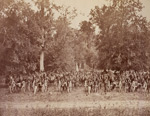Click Center Image for Full Size Picture
A uniform was the outward mark that a civilian had become a soldier. When Cheney and his men arrived at Camp Butler, Illinois, they were anxious to get their first uniforms. During the Civil War, enlisted men were issued uniforms while officers had to purchase theirs.
Infantry uniforms were notoriously ill-fitting. Soldiers joked that they came in two sizes—too big and too small. Artillery uniforms were of overall better quality and better fit. "Better uniforms" served as a recruiting point for the light artillery. Light artillery units wore the same short jacket as the mounted cavalry instead of the long frock coat worn by the infantry. The jackets were neatly trimmed in the red of the artillery. Their light blue trousers were reinforced to better handle long periods of riding. Cheney wrote to his wife, Mary, on February 13, 1862, that the men had received their uniforms and were "very much pleased with them."
Uniforms alone did not make a soldier. The light artillery, predecessors of today's field artillery, needed training to become efficient teams. Cheney's Battery learned the care and use of their artillery pieces at Camp Butler, Springfield Arsenal, and Benton Barracks, which was near St. Louis. Light artillery units did "standing-gun drills" until all the men knew each job. When Cheney's Battery eventually received horses, they began "battery drills," practicing moving their guns into position. Although the soldiers learned how to gauge distances, the Civil War Army did not place much stock in target practice. Headquarters believed it an unnecessary waste of ammunition.
Camp Butler, Illinois.
For volunteer units, the unit's training level, discipline, and overall welfare depended on the quality of their officers. Cheney had some past militia experience with artillery, and was fortunate to have a veteran of the Mexican-American War in his unit, 1st Lieutenant Henry Benn. Like many dedicated civilians-turned-officers, Cheney spent his nights studying tactics and learning the "Army way" of doing things in order to teach his men during the day.
All the training paid off for Cheney's Battery. At Benton Barracks, the Chief of Artillery Colonel Dubois considered the battery to be one of his best. Cheney reported to Mary on December 10, 1862, that Major General William T. Sherman had complimented the unit on its discipline and battery drill during a review. Sherman reportedly said that if he could, he would request the battery for his command.





